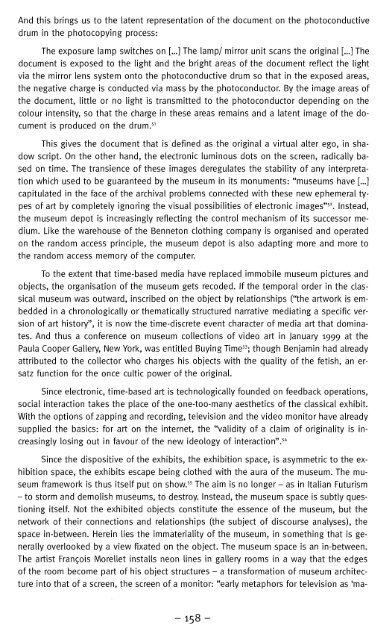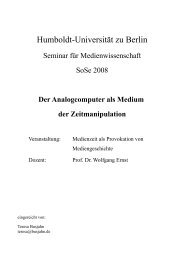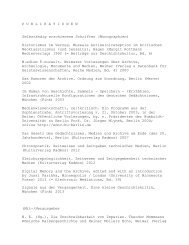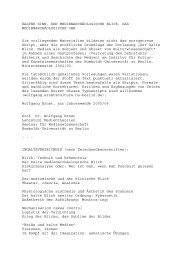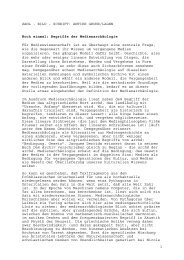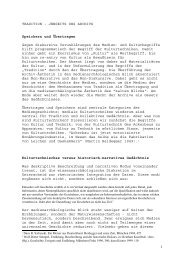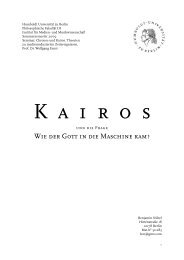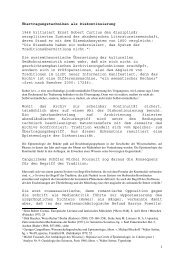Download - Medienwissenschaft
Download - Medienwissenschaft
Download - Medienwissenschaft
You also want an ePaper? Increase the reach of your titles
YUMPU automatically turns print PDFs into web optimized ePapers that Google loves.
And this brings us to the latent representation of the document on the photoconductive<br />
drum in the photocopying process:<br />
The exposure lamp switches on [...] The lamp/ mirror unit scans the original [...] The<br />
document is exposed to the light and the bright areas of the document reflect the light<br />
via the mirror lens system onto the photoconductive drum so that in the exposed areas,<br />
the negative charge is conducted via mass by the photoconductor. By the image areas of<br />
the document, little or no light is transmitted to the photoconductor depending on the<br />
colour intensity, so that the charge in these areas remains and a latent image of the document<br />
is produced on the drum. 51<br />
This gives the document that is defined as the original a virtual alter ego, in shadow<br />
script. On the other hand, the electronic luminous dots on the screen, radically based<br />
on time. The transience of these images deregulates the stability of any interpretation<br />
which used to be guaranteed by the museum in its monuments: "museums have [...]<br />
capitulated in the face of the archival problems connected with these new ephemeral types<br />
of art by completely ignoring the visual possibilities of electronic images" 52 . Instead,<br />
the museum depot is increasingly reflecting the control mechanism of its successor medium.<br />
Like the warehouse of the Benneton clothing company is organised and operated<br />
on the random access principle, the museum depot is also adapting more and more to<br />
the random access memory of the computer.<br />
To the extent that time-based media have replaced immobile museum pictures and<br />
objects, the organisation of the museum gets recoded. If the temporal order in the classical<br />
museum was outward, inscribed on the object by relationships ("the artwork is embedded<br />
in a chronologically or thematically structured narrative mediating a specific version<br />
of art history", it is now the time-discrete event character of media art that dominates.<br />
And thus a conference on museum collections of video art in January 1999 at the<br />
Paula Cooper Gallery, New York, was entitled Buying Time 53 ; though Benjamin had already<br />
attributed to the collector who charges his objects with the quality of the fetish, an ersatz<br />
function for the once cultic power of the original.<br />
Since electronic, time-based art is technologically founded on feedback operations,<br />
social interaction takes the place of the one-too-many aesthetics of the classical exhibit.<br />
With the options of zapping and recording, television and the video monitor have already<br />
supplied the basics: for art on the internet, the "validity of a claim of originality is increasingly<br />
losing out in favour of the new ideology of interaction". 54<br />
Since the dispositive of the exhibits, the exhibition space, is asymmetric to the exhibition<br />
space, the exhibits escape being clothed with the aura of the museum. The museum<br />
framework is thus itself put on show. 55 The aim is no longer - as in Italian Futurism<br />
- to storm and demolish museums, to destroy. Instead, the museum space is subtly questioning<br />
itself. Not the exhibited objects constitute the essence of the museum, but the<br />
network of their connections and relationships (the subject of discourse analyses), the<br />
space in-between. Herein lies the immateriality of the museum, in something that is generally<br />
overlooked by a view fixated on the object. The museum space is an in-between.<br />
The artist Frangois Morellet installs neon lines in gallery rooms in a way that the edges<br />
of the room become part of his object structures - a transformation of museum architecture<br />
into that of a screen, the screen of a monitor: "early metaphors for television as 'ma-<br />
-158-


